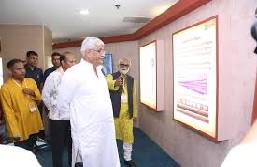21 September, 2025
First ‘Gyan Bharatam’ International Conference
Thu 11 Sep, 2025
Context
- The first ‘Gyan Bharatam’ International Conference is being organized by the Ministry of Culture from 11–13 September 2025 in New Delhi.
Introduction
- This conference is a historic effort to showcase India’s ancient manuscript heritage and knowledge traditions on a global platform.
- Its objective is to preserve, promote, and present India’s rich cultural and intellectual legacy in a modern context.
- ‘Gyan Bharatam’ is an important scheme announced by the Prime Minister, under which manuscripts across the country will be surveyed and catalogued.
- The conference is also seen as a tribute to the anniversary of Swami Vivekananda’s historic address at the World Parliament of Religions in Chicago (1893).
- Theme: “Reclaiming India’s Knowledge Heritage through Manuscript Legacy”
Objectives of the Conference
- Manuscript Preservation: India possesses over 10 million manuscripts, covering diverse fields like philosophy, science, medicine, literature, art, and rituals. The conference will focus on policies and techniques for their preservation.
- Global Collaboration: Bringing together scholars, researchers, and cultural experts from across the world to share India’s intellectual heritage.
- Digitization and Access: Preserving manuscripts in digital format and making them accessible to researchers and the public worldwide.
- Youth Participation: Launching the “Manuscript Research Partners (MRP)” program to provide training and research opportunities to young scholars.
- Cultural Diplomacy: Strengthening India’s global image as a leader in cultural and intellectual heritage.
Participants and Program
- Over 1100 authors, experts, scholars, artists, and cultural practitioners will participate, including:
-
- 95+ academicians
- 179 professionals
- 112 scholars
- 230 students
- The conference will host 17 national and 17 international speakers.
- It will feature 3 days of sessions: an inaugural and valedictory session, 4 plenary sessions, and 12 technical sessions.
Vision and Objectives of Gyan Bharatam Mission
- India’s cultural and intellectual heritage is reflected in its vast manuscript wealth, estimated at over 5 million works.
- These texts span philosophy, science, medicine, mathematics, astronomy, literature, art, architecture, and spirituality.
- Written in multiple scripts and languages, they are preserved in temples, monasteries, Jain bhandaras, archives, libraries, and private collections.
- Together, they form a unique record of Indian knowledge systems, showcasing the continuity of India’s civilizational thought.
- In the current financial year (2025–26), the mission has been allocated ₹60 crore, as part of a Central Sector Scheme with a total outlay of ₹482.85 crore for 2024–31.
National Mission for Manuscripts (NMM)
Importance of Manuscripts
- Definition: A manuscript is a handwritten document on palm leaves, birch bark, cloth, paper, or metal, at least 75 years old.
- Characteristics:
-
- Different from printed books or administrative records
- Rich in knowledge content
- Covers diverse subjects: philosophy, medicine, astronomy, literature, and art
- Found in multiple languages and scripts (e.g., Sanskrit written in Devanagari, Odia, and Grantha scripts)
National Mission for Manuscripts (NMM)
- Established: 2003
- Objective: Preservation of India’s intellectual traditions and manuscript heritage
Key Initiatives
1. Kriti Sampada (Digital Repository)
- Documented over 4.407 million manuscripts
2. Manus Granthavali (Software Development)
- Based on global metadata standards
- Ensures accuracy and uniformity in documentation
3. Partnerships with Repositories
- Major libraries include:
-
- Sarasvati Mahal Library (Thanjavur)
- Rampur Raza Library (Rampur)
- Khuda Bakhsh Library (Patna)
- Thousands of smaller collections across India brought into focus
4. CAT-CAT Initiative (Catalogue Database)
- Compiled 2500+ printed catalogues
- Integrated listed works into the national record
Gyan Bharatam Mission and the Future
- Built on the foundation of NMM, the Gyan Bharatam Mission aims to create a modern, technology-driven framework.
- Seeks to preserve India’s intellectual traditions and make them relevant in the digital age.
National Education Policy (NEP) 2020 and Indian Knowledge System (IKS)
- Language-Based Learning: Promotes mother tongue/regional language as the medium of instruction up to Grade 5.
- Culture and Tradition: Encourages promotion of Indian languages, arts, and heritage.
- Integration of IKS:
-
- Incorporates ancient contributions in science, philosophy, medicine, and literature into modern curriculum.
- Prime Minister’s Vision: Empowering youth to become custodians of heritage while embracing innovation.
- Shared Objective (NEP + Gyan Bharatam Mission):
-
- “Knowledge of the Past as the Strength of the Future”


















